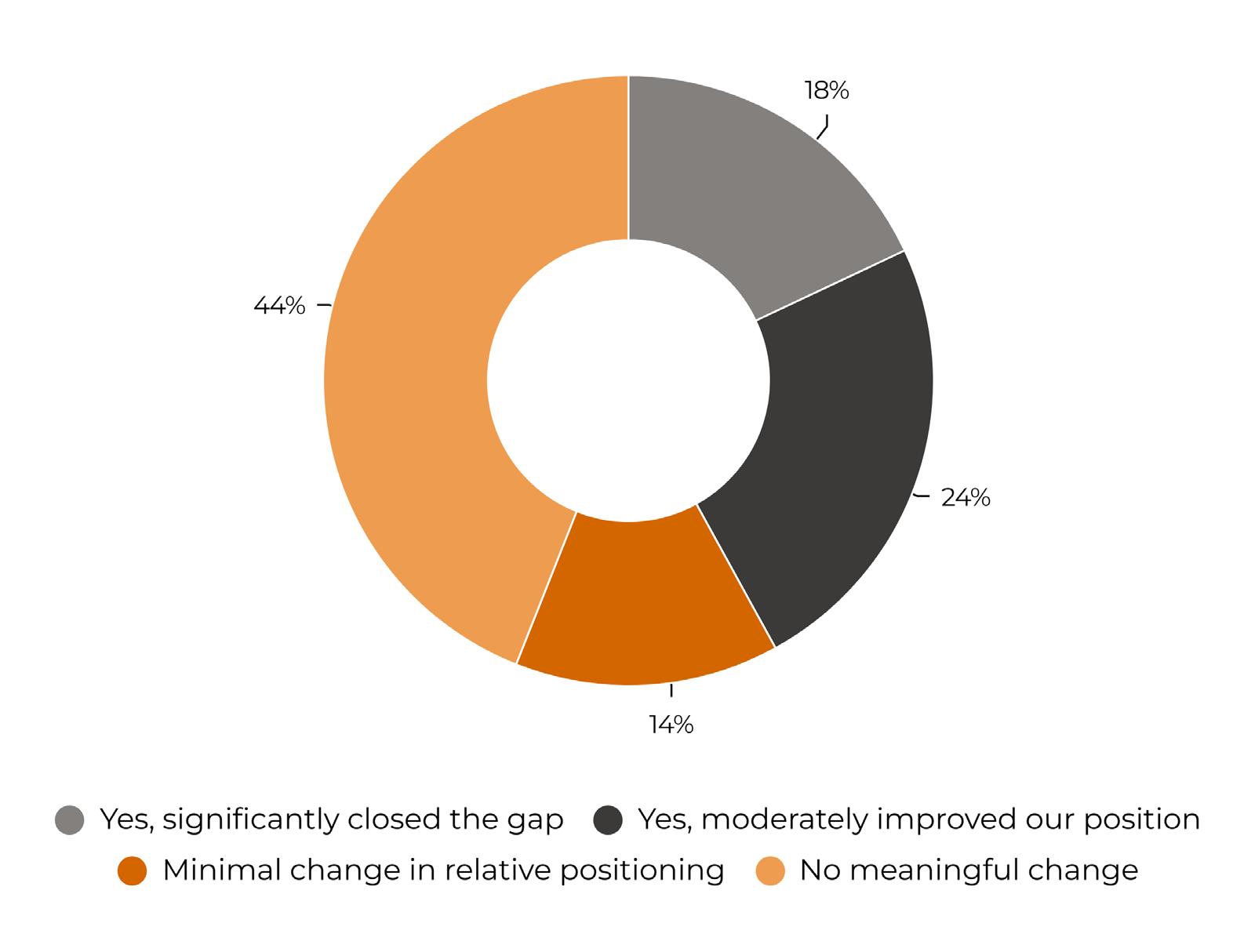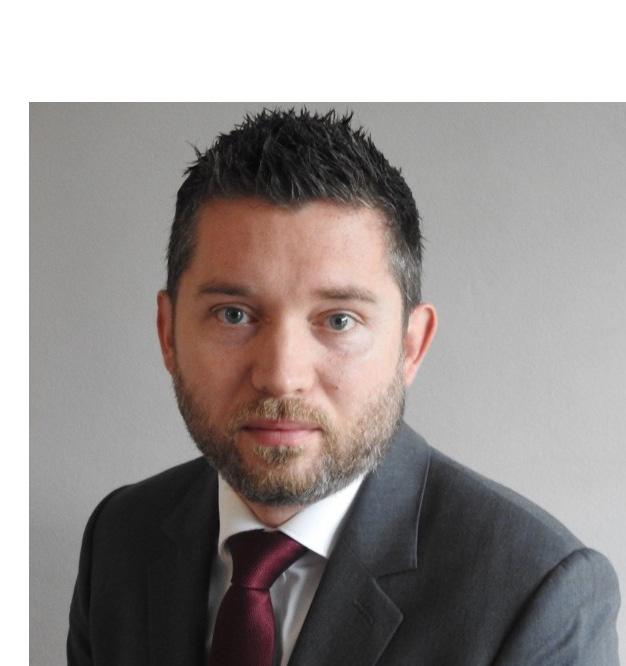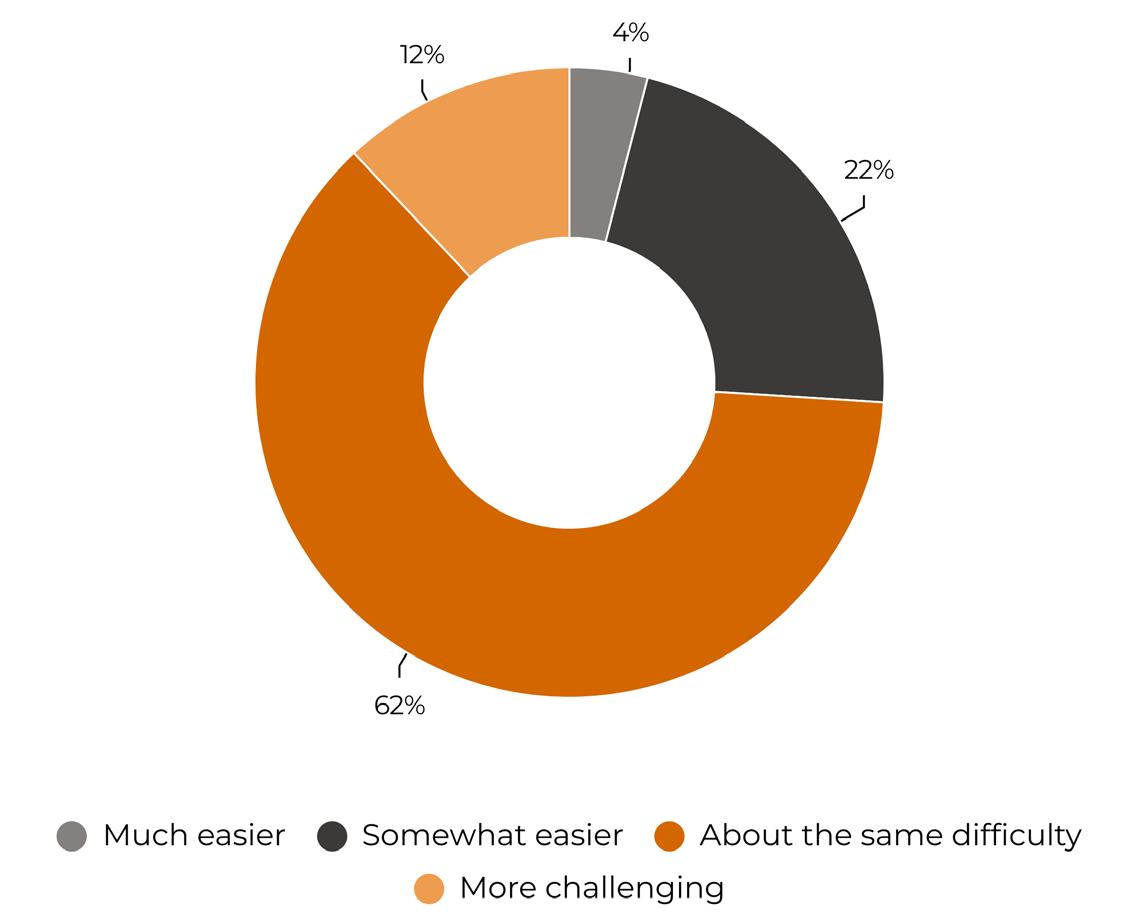SPONSORED BY:



HOW HEDGE FUNDS ARE BUILDING TOMORROW’S PORTFOLIOS TODAY OCTOBER
HEDGE WEEK



SPONSORED BY:



HOW HEDGE FUNDS ARE BUILDING TOMORROW’S PORTFOLIOS TODAY OCTOBER


The hedge fund industry is undergoing a quiet but profound shift in its multiasset capabilities. Over the past two years, roughly three-quarters of managers operating across multiple asset classes have redefined their investment approach – either by expanding into new markets or by materially refining their existing strategies.
This evolution reflects the convergence of three powerful forces: growing allocator pressure for diversification, the democratisation of institutional-grade technology, and a steadily rising operational bar for securing mandates.
Yet beneath this momentum lies a paradox. While most managers believe advances in technology have narrowed the capability gap with their billiondollar peers, nearly half report no improvement in their competitive position. Many claim few constraints on their multi-asset ambitions, even as allocators impose unprecedented infrastructure requirements; more than half now regard institutional-grade operations as a non-negotiable standard.
The data points to a market in transition. The most ambitious managers – those expanding their multi-asset offerings most aggressively – are also the ones feeling the sharpest technological constraints. And despite broad improvements in capability, 62% of managers say winning institutional mandates is no easier than it was 18 months ago. The competitive bar, it seems, is rising faster than firms can adapt.
This report examines four dynamics at the heart of this transformation: constant change, the equalising effect of technology, shifting allocator preferences and operational transformation.
MANAS PRATAP SINGH
METHODOLOGY
The key source of data in this report is the Hedgeweek Manager and Allocator Survey conducted over Q3 and Q4 of 2025. Over 100 hedge funds and asset managers, along with allocators (pension funds and insurers) participated, representing hedge funds across major global domiciles, strategy types, and AUM categories. Further insights were gathered during interviews in October 2025 with both named and unnamed sources, as well as through additional market intelligence.
Enterprise technology has become available to hedge funds of all sizes. The rise of institutionalgrade, cross-asset trading platforms is transforming the competition position of smaller hedge funds. Technology that was once the preserve of billion-dollar firms is now accessible via scalable SaaS solutions, allowing small and mid-sized managers to operate on nearly equal technological terms – confirmed by more than half of these hedge funds.
2
There is a widening gap between allocators’ expectations and managers’ awareness of their requirements. A sharp escalation in asset allocators’ desired operational and governance standards was identified in Hedgeweek® surveys conducted earlier this year. More than half of allocators view institutional-grade service providers as a minimum requirement for emerging managers, while three-quarters say it is an immediate red flag if an independent fund administration is absent.
3 4
Operational constraints surface as infrastructure matures. Technology continues to be a key driver of multi-asset expansion across the hedge fund industry – but managers that have significantly broadened their multi-asset strategies point to technology or platform constraints as the main barrier to further growth.
The new reality that having the right platform is necessary – but no longer sufficient – for sustained competitive advantage. Even as hedge funds enhance their operational capabilities, most managers say the competition for institutional mandates remains as fierce as ever. With investors’ expectations for technological infrastructure continuing to rise, firms now need to upgrade simply to maintain their standing.

Chart 1a: Investment approach evolution (All Hedge Funds)

The pace and direction of the evolution in multi-asset hedge fund investing has been striking. Over the past 18-24 months, the overwhelming majority of hedge fund managers have undertaken significant changes to their investment approaches.
Just under 70% (see chart 1a) report having actively evolved their strategy, with 21% expanding into new asset classes and a further 41% refining their existing approaches within current exposures.
Only under one-third (31%) say they have made no major changes, underscoring the industry’s broad momentum toward diversification and strategic recalibration.
This gets even more pronounced for those who already trade more than one asset class. Over a three-quarters (see chart 1b) have tweaked their strategies in favour more comprehensive offerings. Within those, just under half have either added new asset classes to their offering or “expanded their multi-asset offerings significantly”.
The popularity of multi-asset could be driven by push factors – alpha sources drying up elsewhere – or pull factors that are improving prospects for the strategy.
The hedge funds interviewed for this report have evolved their investment approaches in a variety of ways over the last couple of years – with a common theme of adapting to particularly uncertain market conditions.
its Laniakea Special Opportunities Fund, operates globally, trading relative value (RV) volatility across global equity indices, FX, rates, commodities and crypto. This provides it both with the flexibility to be opportunistic and the ability to diversify its return sources, according to Lisa Conibear, UK and Group CEO, Laniakea Funds.
She says: “The world has become a little less predictable in the past 12 months, so we have adapted our approach. Policy unpredictability can make it tougher for RV volatility trading as we rely on historical relationships. As a result, our investment process has become more adaptive and at times more discretionary in nature.”
Findlay Franklin, portfolio manager, multi-asset credit, at RBC BlueBay Asset Management, says: “In today’s uncertain market environment, our positioning continues to prioritise risk-adjusted returns over absolute gains. With fixed income spreads at multi-decade highs and global equities pushing record highs, we have limited appetite for taking significant directional risk.”
He maintains a balanced approach to the portfolio, equally weighted between bottomup idiosyncratic story driven strategies –emerging markets and event driven – and non-directional, RV strategies focused on exploiting dispersion and dampening volatility, specifically investment grade and securitised credit.
Source: Q4 2025 Manager Survey
Laniakea Funds – the winner of Hedgeweek’s 2025 US award for Emerging Performance of the Year: Discretionary Macro Fund, for
“Our holistic investment platform is built on the back of some powerful proprietary technologies – this allows us to cast the net ®

Source:
wide, leaving no stone unturned across the fixed income investment space – with a consistent and repeatable investment approach which is approachable and executable to all PMs across the platform,” Franklin says.
“As we use an internally developed platform, we’re able to take both the feedback of analysts, strategists and PMs into consideration when developing the technology further, but we can also include new development in technology externally.”
Alain Zeitouni, head of multi asset at Russell Investments, has a more positive perspective on the direction of markets. “With the strength of the US economy and most central banks moving to a more accommodative monetary policy, we have a constructive view on equity markets and growth assets in general.”
His team prefers emerging markets equities, given their historic low valuations and likely exposure to a growth uptick, and convertible bonds, given their unique access to high growth companies. “We have also reduced our exposure to investment grade corporate bonds given the historic low level of spreads and therefore lower expected returns going forward,” he says.
“Our investment approach has not changed over the last two years, and is still based around the analysis of cycle,
valuations and sentiment. With the sell-off in markets following ‘Liberation Day’, our sentiment indicator had moved to extreme levels of panic, so we took this opportunity to add to growth assets in our portfolios early, in April, after the sharp market correction.”
Iguana Investments is predominantly an equity long-short manager in developed market equities but also has FX exposure, including forwards and spots. On the short side it runs synthetic equity swaps, covering several asset classes.
Fahd Ahmed, CEO of Iguana Investments, says his fund is “not completely bearish on the world” but has taken more defensive positions in names such as gold miners. That said, it has also added riskier names including US banks and financial entities.
Ahmed says: “In other asset classes, a larger proportion of the book is now hedged via FX forwards. A larger portion of the book is now held in options, which are used to add hedging and protects the fund when it comes to [guarding against] precipitous declines in the market.”
He adds that the fund is also holding more cash-equivalent assets. “That’s one of the larger changes, whereby we take more risk on the equity book but add in a lot more balancing in cash and hedging instruments. Capital preservation is key in such environments.”
Ironhold Capital trades only public equities but does diversify globally and increasingly relies on technology. “Our investment philosophy has not changed fundamentally,” says managing partner Siddharth Singhai. “What has evolved is execution. We now use proprietary, in-house AI tools to summarise filings and accelerate the grunt work. Our core principles remain unchanged – value investing, margin of safety, ‘Mr. Market’ concept [irrational and contradictory beliefs exist in markets], market efficiency and buying high-quality businesses.”
Thomas Rice, portfolio manager and cofounder at Minotaur Capital, says: “Our Global Opportunities Fund is a long-biased global equities strategy built to outperform in all market conditions. Our AI system filters thousands of companies based on qualitative data in a way you couldn’t do before modern LLMs (large language models) were available. The goal is for pure stock selection, powered by AI, to be the main driver of returns, which is why we intentionally diversify across regions, sectors, and factors. That said, we’re currently underweight the US and overweight Europe and Asia, where valuations look more compelling and market inefficiencies remain greater.”
When Minotaur Capital launched in late 2023 its goal was to see how far AI could integrate with fundamental investing, without legacy constraints. It begun by using AI for researching companies. “Today, it’s central to our research process,” he says. “Our AI models can now read and write directly to our research files, monitor the individual stocks we own in real time, and flag material developments as they happen. We start the day already on top of what’s moving markets, and our portfolio.”
Tom Hawthorn, head of manager research and a senior investment consultant at Cartwright Pension Trusts, specialises in advising defined benefit (DB) pension schemes, up to £200 million. He notes that as DB funds funding levels
have significantly improved, most don’t currently need to chase returns. “They [multi-asset hedge funds] are not a particularly good fit in terms of complexity, fees, opacity, lack of liquidity and sometimes lock-up periods,” he adds.
Hawthorn says: “Our clients’ allocations to multiasset strategies have decreased [over the last 18 months], as funding levels continue to improve for the bulk of DB pension schemes. They have generally become low-risk bond investors, largely in gilts. They don’t need as much extra return above the level needed to match liabilities.”
This de-risking means its schemes invest less in all types of return-seeking assets, not just multiasset. “But if we strip out de-risking, investing in multi-asset across credit, equity, real estate and other alternatives has not really changed,” he says.
Hawthorn also works indirectly with insurers that write policies for DB pension schemes liabilities. “The situation is slightly different for insurers, as they can aggregate assets against the pool of liabilities. They tend to take a bit more risk in terms of duration and credit risk, but I suspect most insurers’ exposure to would be minimal, as they’d potentially have a liquidity mismatch,” he adds.
Payam Kazemian, accredited pension trustee and client director at Zedra Governance, says: “The use of technology is increasing, especially in terms of the use of artificial intelligence (AI). It has started to be used in the assessment of advisors and to provide more accurate and streamlined services. Technology is a big area.
“In particular, modelling, updated in real time, allows pension schemes to manage their risks. Technology facilitates more sophisticated reporting – so, when we ask hedge fund managers questions, they can provide answers without the need to go back to look at spreadsheets.”
“
The world has become a little less predictable in the past 12 months, so we have adapted our approach … Our investment process has become more adaptive and at times more discretionary in nature.
LISA CONIBEAR UK and Group CEO, Laniakea Funds

Access to institutional-grade, crossasset trading platforms is reshaping the competitive landscape for smaller hedge fund managers. Tools once reserved for billion-dollar firms are now available through scalable SaaS models, enabling small and mid-sized managers to compete on near-equal technological footing.
More than half (55%) of managers believe technology has meaningfully narrowed the capability gap with large peers: 18% significantly, 24% moderately and 14% minimally. However, 44% report no change in their relative position to multi-billion-dollar funds, highlighting that while technology access has become more ‘democratic’ the confidence of some smaller funds to competitively differentiate themselves technologically remains elusive.
The question is whether this 44% is correct in their evaluation or are just unaware of the third-party technology solutions that could potentially close the gap.
Iguana’s Ahmed says the gap has “certainly” narrowed over the last decade. “It started with hedge funds moving to the cloud. For example, we have access to powerful risk engines that are also used by some of the largest asset managers in the world – our risk controls and risk measurement systems are more than adequate.
“You can now start a hedge fund with a handful of experienced, good-quality personnel. We can outsource some functions – so we don’t need to have an expensive CRO in-house. Ultimately you can do that [work] using systems and tech.”
Iguana mainly use AI for tasks such as client communication. “It’s not deeply ingrained into our investment process,” he says.
Ahmed adds that while the gap has narrowed in the last two years, this may not continue. While he says it is “exciting to be nimble” enough to run local AI models, over the longer term it may become difficult to compete with largest funds’ dedicated AI teams.
“The gap between us and the larger players has perhaps only temporarily narrowed. It’s nascent tech and we’ve all started off on the same ground – but I suspect, because larger players can dedicate more resources to AI, they’ll end up catching up with the junior startups and maybe end up with a greater advantage.”
Minotaur’s Rice says: “If anything, the capability gap has widened. As early adopters, we’re building tools that simply don’t exist inside traditional investment firms. We’re not trying to make analysts marginally more efficient – we’re creating entirely new ways of discovering and validating investment ideas. Because

we’re unburdened by legacy systems, we can rethink the investment process from the ground up.”
Ironclad’s Singhai says AI and technology have “somewhat” narrowed the gap. “We don’t require many junior analysts to handle grunt work, which reduces potential costs significantly. Our concentrated strategy, compared to most large managers, further reduces the need for extensive personnel.”
The biggest change for small asset managers, according to Conibear, is that improved technology has reduced barriers to entry. “This allows startup firms like ours to launch more quickly and to build institutional-grade capabilities faster.”
When selecting managers, Hawthorn draws an “important distinction” between using technology to manage assets and run a portfolio more efficiently and relying on it for decision making and adding value.
“Chasing alpha should be based on human decisions – while technological advantages to make running a portfolio more efficient are desirable.” He adds: “I wouldn’t want a manager to be too reliant on technology to generate alpha. Relying on technology works – only until it doesn’t. A hedge fund too reliant on technology to follow trends could come unstuck when that trend reverses. That said, using AI
and models can be useful. If you don’t over rely on them, and you continue to tweak or update them to allow for changes in the environment, they can work well.”
Hawthorn says smaller managers will never be able to compete with the largest managers in terms of technology capabilities – but that may not matter. “They don’t have the same financial firepower. But their range of technological firepower doesn’t necessarily put them at a disadvantage. It’s also about how you use it and how necessary it is for whichever asset classes they’re managing. If it’s done well, smaller managers can use outsourced providers if they need to fill gaps.”
Zedra’s Kazemian adds: “Modelling systems are very important to pension funds as they need to assess their assets and liabilities. Having upto-date assessments improves risk management.”
“It is difficult to tell the extent to which hedge funds are investing in technology. We are told tech is a major area of investment by most funds –by mature ones as well as those that are growing. Technology is not just important in the area of investment – for example it is also key to the administration of pension benefits. Investment consultants look closely at hedge funds’ technology when advising pension schemes.”
“
Chasing alpha should be based on human decisions – while technological advantages to make running a portfolio more efficient are desirable.
TOM HAWTHORN Head of Manager Research and a Senior Investment Consultant, Cartwright Pension Trusts

RONAN FARRELL
Three-quarters of fund managers we surveyed have evolved their investment approach in the past 18-24 months, with a quarter adding new asset classes. What’s driving this? Is it allocator pressure, genuine alpha opportunity, or something else?
In the past two years, fund managers haven’t just tweaked their strategies – they’ve turbocharged them. The real catalyst? A data revolution. Forget just allocator pressure or chasing alpha: today’s leaders are harnessing advanced analytics and alternative data to spot opportunities and risks faster than ever.
What’s new isn’t just the tech, but how managers are using it. They’re taking proven data-driven playbooks from equities and applying them to credit, private markets, and beyond – wherever they can maintain an edge. The result? Smarter, faster, and more adaptable investment decisions.
In a world where information moves at lightning speed, those who master datadriven decision making – and can scale it across asset classes – are the ones who’ll stay ahead of the pack.
Many hedge fund managers believe technology has narrowed the multi-asset capability gap with large hedge funds and asset managers, but many others see no meaningful change.
From your point of view, working with funds across the size spectrum, what’s driving this perception gap? Are smaller managers genuinely unaware of available platforms, or is there a disconnect between platform capabilities and realworld outcomes?
The split on tech’s impact isn’t just about who’s using the latest platforms – it’s about who’s ready for the new rules of the game. As regulations like MiFID II and AIFMD push talent from sell-side banks to hedge funds and asset managers, the bar for operational sophistication keeps rising.
Smaller managers who still rely on legacy or single-asset systems are feeling the squeeze. The real winners? Those investing in nextgen, cross-asset platforms that can handle today’s complexity and tomorrow’s growth. In this new era, bridging the perception gap means building for scale, speed, and regulatory agility—because standing still is no longer an option.
Half of all hedge fund managers claim nothing significant constrains their multiasset capabilities, yet we see modest actual expansion into new asset classes. Meanwhile, the managers who’ve pushed hardest into multi-asset all cite technology as their binding constraint. What does this tell you about the state of operational selfawareness in the industry?
The multi-asset and hybrid fund boom is rewriting the rules for hedge funds and private asset managers alike. Whether it’s a private markets giant taking on institutional inflows and needing robust liquid asset capabilities, or a derivatives-focused hedge fund chasing alpha in new, modellingheavy asset classes, one thing is clear: the operational bar has never been higher.
So why do half of managers say, “no constraints,” while the real innovators flag technology as their biggest hurdle? It’s a classic case of operational self-awareness. Many managers are only now realising that legacy systems and patchwork solutions can’t keep up with the complexity and speed of today’s cross-asset world. Growth in multi-asset and hybrid funds demands more from the front office – especially from the IBOR platform, which must deliver realtime, unified data across public and private assets, support sophisticated risk analytics, and empower PMs to make fast, informed decisions.
In this new era, the funds that thrive will be those honest enough to recognise their tech gaps – and bold enough to invest in platforms that turn operational complexity into a competitive edge.

Three-quarters of multi-asset managers have evolved their approach recently, but they hit different constraints at different stages: technology limits for aggressive expanders, operational expertise for incremental adopters. From your implementation experience, what’s the best roadmap? At what points do managers typically realise their current infrastructure won’t suffice?
The best roadmap for multi-asset managers? Build for flexibility and scale from day one. As Hedge Fund managers broaden their strategies – often by introducing multi-asset approaches that sit above their original investment pillars – their success depends on two key factors: having access to a robust ecosystem and being able to quickly develop and implement new solutions.
The tipping point usually comes when managers try to scale into new asset classes or geographies and realize their legacy infrastructure can’t keep up. That’s when the need for a robust, front-to-back platform becomes clear. Here’s where having a major fintech partner, like FIS, pays off. With a deep catalogue of ready-made solutions and a proven integration track record, these partners help managers plug into a global ecosystem, accelerate development, and support rapid client expansion – without reinventing the wheel.
In today’s market, the winners are those who combine operational self-awareness with the right partners and platforms to turn ambition into action.

Despite widespread improvements in operational capability among hedge funds, most managers report no easing in the competition for institutional mandates. This means that rising institutional expectations for technology infrastructure means that hedge funds need to make improvements to just to tread water.
The clear majority (62%) see no change while 12% believe securing mandates has become even more challenging. Only 26% say it has become easier to win mandates over the past 18 months (4% much easier, 22% somewhat easier).
These findings suggest that as more managers elevate their infrastructure and investment sophistication, the competitive bar continues to rise, keeping relative differentiation flat across the market.
The perceptions of managers may be somewhat obscured by the increasing relative popularity of multi-asset funds, due to their potential to produce uncorrelated returns.
Conibear says: “Given the current uncertainty, we’ve found that institutional, as well as non-institutional, investors are increasingly looking for uncorrelated, niche strategies. That has made conversations somewhat easier for us, as our approach fits that demand.”
Franklin says: “Generally, we’d say that both consolidation in the institutional space and scale of the mega-cap multi-strategies has made discussions harder. However, our fund’s growth in recent years has made what were impossible conversations not long ago – due to concentration limits – into genuine opportunities.”
Iguana’s Ahmed says: “It’s probably unchanged in terms of difficulty. From Iguana’s perspective, it’s become slightly easier as we surpassed the three-year track record threshold. For the industry, the challenges are probably unchanged – it’s a difficult capital raising environment – and investor concentration percentages are still a challenge for institutional investors investing in startups.”
Minotaur’s Rice says: “Institutional interest in AI-driven investment strategies has grown dramatically over the past 18 months. Expectations have risen, too. Investors now want to see tangible, working applications of AI, not just experimentation. We’re much further along than I expected we would be a year and a half ago, but it still feels like we’re only scratching the surface of what’s possible.”
In the pension fund world “it is very important to be able to operate across multiple asset classes and diversify across different asst classes, currencies and jurisdictions,” according to Kazemian. However, the ability to win mandates does not just depend on the multi-asset layer – it also depends on the strength in each individual asset class. Cartwright’s Hawthorn says, when selecting new mandates, a manager’s ability to operate across multiple asset classes is “potentially quite interesting – but it’s more about skills within the teams managing each asset class”.
He adds: “For example, we ideally want career analysts for public credit as they become better at their job over time. Whereas, in more niche credit universes, we want specialists in individual areas, such as mortgages.”





“ It is very important to be able to operate across multiple asset classes and diversify across different asst classes, currencies and jurisdictions.
PAYAM KAZEMIAN Accredited Pension Trustee and Client Director, Zedra Governance
Allocator context
Hedgeweek® allocator surveys conducted earlier in 2025 highlight a sharp escalation in operational and governance standards for hedge fund managers. More than half (56%) of allocators view the use of institutional-grade service providers as a minimum requirement for emerging managers, while three-quarters flag the absence of independent fund administration as an immediate red flag.
Operational readiness is also under greater scrutiny in 2025: 64% of North American allocators cite clear scaling roadmaps as a key comfort factor when assessing new managers. Meanwhile, diversification remains the dominant allocation theme, with 70% of allocators increasing exposure citing it as their primary motivation (Q3 2024 survey).
Kazemian says: “There has not been a general shift [in multi-asset investing] within DB pension funds, although individual schemes may make changes due to their circumstances. When making allocations, it is not just performance that matters – it also depends on the scheme’s journey plan, assets and liabilities, and the covenant strength of the employer.”
“There has not been much change because pension funds have long-term plans – perhaps 15 years – so 18 months is a short timeframe. The LDI (liability-driven investment) crisis (in 2022) and other market gyrations demonstrated the potential for interest rate risk – but since then there have been no major events. Generally, schemes have not made major asset allocation decisions.”

Source: Q3 2024 Allocator Survey

The hedge fund survey respondents suggest that technology infrastructure is maturing and the extent it acts as a constraint differs according to the stage of a hedge fund’s evolution.
Technology remains the defining factor shaping multi-asset growth across the hedge fund industry. Every manager who has significantly expanded their multi-asset offerings cites technology or platform limitations as the primary constraint on further progress.
Conibear says: “Operational resources remain the main constraint. Running multi-asset, cross-time-zone portfolios requires significant infrastructure and coordination.”
Among those that have added only a few new asset classes, one-third point to challenges in operational resources and expertise.
Overall, however, most hedge funds – including most emerging managers – report few meaningful barriers to execution, reinforcing the idea that technology access is becoming a great equaliser.
Half of all respondents (50%) say nothing significant constrains their multi-asset ambitions, while 12% point to operational resourcing and expertise, 8% to technology or platform limitations, and 6% to regulatory or compliance hurdles.
For context, a Hedgeweek survey conducted earlier this year found that 35.2% of managers identify adding new funds as their most challenging operational hurdle.
Minotaur’s Rice says: “Time is our biggest constraint, not technology. Building truly novel systems takes iteration and experimentation. While we’re a small team, that’s also our edge. It allows us to move faster and build with purpose. After all, many of the world’s best software
products were created by small, focused teams.”
Zeitouni says: “Regulation is by far the biggest constraint when it comes to our multi-asset capabilities. The regulators have not yet allowed us to incorporate private assets into our mutual funds. Solvency II can also be a constraint for our insurance business in terms of eligibility of asset classes to invest in.
“We also still face regulatory hurdles when it comes to incorporating more alternative strategies, especially around liquidity. Using a segregated account structure allows us to overcome most of these hurdles and to build client dedicated portfolios that incorporate more innovative asset classes.”
Nearly a quarter (24%) of the surveyed funds do not currently pursue multi-asset strategies. Iguana’s Ahmed says: “One of the reasons [we are not fully multi-asset] is the ongoing talent war on the personnel side. To become truly multi-asset, we would need to bring in other fund managers to run a sleeve for each of the other asset classes. The technology and operational resources would then follow.”
However, he says, “one of the things we’re excited about is that the financial industry is having a bit of a renaissance when it comes to new talent” and notes Iguana is increasingly able to able to attract Cambridge University interns when previously they may have gone to tech and AI firms.
“We wouldn’t need to invest a great deal of accretive capital to run a truer multi-asset book. We have a core focus, but as the business grows we may well [add more classes]. We are a start-up and are already planning to add a long infrastructure fund. We’re better off starting with a single strategy and then expanding – and the business is now in a good position to be able to do that.”

CONTRIBUTORS:
Manas Pratap Singh Head of Hedge Fund Research manas.singh@globalfundmedia.com
FOR SPONSORSHIP & COMMERCIAL ENQUIRIES:
Please contact sales@globalfundmedia.com
